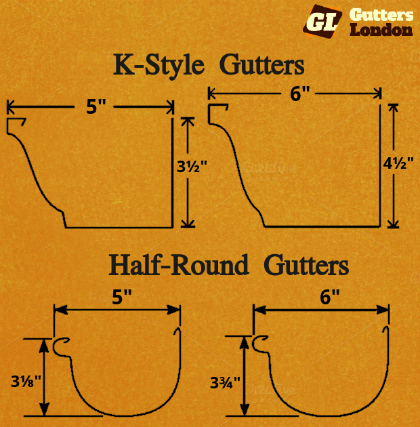What’s The Right Size of Rain Gutters for My House?
 When it comes to installing gutters (new, repair, or replacement), there’s one very important question that you ought to be asking yourself early on in the process: What gutter size do I need?
When it comes to installing gutters (new, repair, or replacement), there’s one very important question that you ought to be asking yourself early on in the process: What gutter size do I need?
There are some serious ramifications to selecting the appropriate gutter size for your property. Pick a gutter that’s too small, and you’ll find it clogs easily, getting blocked with debris and spilling water out over the edges. Go that way, and the whole process of installing gutters may as well have been a waste of time!
On the other hand, though, nobody wants unnecessarily large, bulky plastic pipes pinned up to the outside of their building.
Typically, you’ll find that most houses go for a standard five- or six-inch ‘K-style’ gutter.
These are semi-circular in shape, and ought to handle any kind of normal rainfall. However, houses with larger roofs, particularly steep roofs, or properties located in areas prone to heavy downpours, might want to consider something a little more heavy-duty.
That’s why the experts at the Gutters London Cleaning, Replacement & Repair company have put up this post.
Measuring the Area of Your Roof
The most logical way to choose your gutter size would accord to the area of your roof. Calculate the square footage by getting up there with a tape measure.
If you’ve got a simple gable-end roof, then it’s easy – you only need to know two figures, one for either slope.
With more complex roofing shapes though, this process might take a little longer as you add up the surface area of each individual surface.
Finding Your Roof-Pitch Factor
You must factor in the angle – or ‘pitch’ – of your roof too, when working out what gutter size you need. The steeper your roof, the more rain it’ll catch.
The easiest way to measure the pitch of your roof is by using a two-foot spirit level and tape measure.
- Hold the level against your roof and get it balanced.
- Measure the distance from the centre point of the level, down to the roof below. This will give you a ratio to work with.
Say, for example, you measure 4 inches vertically from the level to the roof, then you can calculate an angle of 12 inches across for 4 inches down: what’s called a 4-in-12 pitch.
With that information, just consult the figures below to find your roof-pitch factor:
Roof pitch — Roof-pitch factor
- 12-in-12 or higher — 1.3
- 9-in-12 to 11-in-12 — 1.2
- 6-in-12 to 8-in-12 — 1.1
- 4-in-12 to 5-in-12 — 1.05
- Flat to 3-in-12 — 1
Finally, you’ll want to take your surface area figure, the measurements you came up with earlier, and multiply that by your roof-pitch factor to find your effective rain-collection area.
So for example, let’s say your roof measured 1,000 square feet – and when you measured its pitch, you found it to be 6-in-12 inches. That gives us a roof-pitch factor of 1.1, which, when multiplied by the total surface area, gives 1,100 square feet. That’s the figure you need to be working with or else you risk a guttering problem.
Picking Your Gutter Size
 Now finally, you can find the appropriate gutter size by looking at the following figures – showing the relationship between different gutter systems and the roof area they’ll be able to drain.
Now finally, you can find the appropriate gutter size by looking at the following figures – showing the relationship between different gutter systems and the roof area they’ll be able to drain.
K-Style
5-inch — 5,520 square feet
6-inch — 7,960 square feet
Half-Round
5-inch — 2,500 square feet
6-inch — 3,840 square feet
Note: Choosing the wrong size could lead to gutters blocked over time.
Conclusion
Following the procedure above should give you a good idea of the gutter size required for your roof. Bear in mind though, that this process is, at best, an estimate. It doesn’t take into account the climate or typical annual rainfall of the area you live in… but it’s a good indication nonetheless of the kind of gutter size you should be looking for.
Remember though – if in doubt, consult a professional drainage technician. Installing rooftop drainage is a major commitment, and it’s worth doing it properly the first time around… both for your sake, and for the sake of your property.
